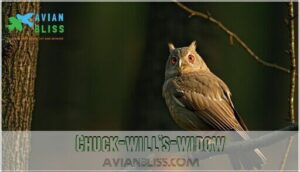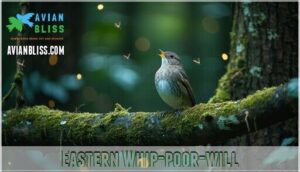This site is supported by our readers. We may earn a commission, at no cost to you, if you purchase through links.

Black-crowned and Yellow-crowned Night Herons patrol wetlands with their distinctive croaks, while Short-eared Owls hunt silently over grasslands.
Common Nighthawks perform aerial acrobatics above city lights, and the Common Pauraque rests camouflaged on roads.
Three nightjar species create the soundtrack of Texas evenings: Chuck-will’s-widow calls from East Texas forests, Eastern Whip-poor-wills repeat their namesake song, and Lesser Nighthawks zip through desert skies.
These nocturnal species have adapted to Texas’s diverse habitats, from coastal marshes to Hill Country, and learning their unique calls and behaviors opens up a whole new world of birdwatching opportunities in Texas’s diverse habitats.
Table Of Contents
Key Takeaways
- You’ll find eight distinct nocturnal bird species in Texas, including Black-crowned and Yellow-crowned Night Herons in wetlands, Short-eared Owls in grasslands, Common Nighthawks performing aerial acrobatics, and three nightjar species that create the soundtrack of Texas evenings.
- You can identify these night birds primarily through their distinctive calls rather than sight – listen for the Chuck-will’s-widow’s five-syllable song, the Eastern Whip-poor-will’s three-note whistle, and the Common Nighthawk’s nasal "peent" calls echoing across the landscape.
- You’ll have the best success spotting nocturnal birds during spring through fall seasons at dusk and pre-dawn hours, using red-filtered flashlights and audio recording devices while visiting coastal hotspots like Galveston Island State Park or public lands such as Big Bend National Park.
- You’re witnessing birds that face serious conservation challenges from habitat loss, light pollution, and climate change – but you can help by participating in citizen science programs like eBird, supporting "Lights Out Texas" initiatives, and practicing ethical birding by maintaining respectful distances from roosting sites.
Types of Nocturnal Birds in Texas
You’ll encounter several distinct groups of nocturnal birds across Texas, including owls, nightjars, herons, and songbirds that become active after sunset.
These night birds range from the massive Great Horned Owl to the elusive Common Nighthawk, each with unique calls and hunting behaviors you can identify in the darkness.
Black-crowned Night Heron
You’ll recognize the black-crowned night heron’s stocky silhouette along Texas waterways after sunset.
Listen for the haunting five-syllable call of Chuck-will’s-widow echoing through Texas forests on moonlit nights.
This chunky wader exhibits classic nocturnal behavior, using specialized night vision to hunt frogs, fish, and crayfish in shallow waters.
Listen for its distinctive barking call echoing through wetlands.
The species prefers dense vegetation near ponds and marshes for roosting.
While conservation status remains stable, protecting Texas’s wetland habitats guarantees these herons continue thriving in their preferred nighttime hunting grounds.
Yellow-crowned Night Heron
You’ll spot this coastal specialist hunting crayfish in Texas marshes during summer months.
Unlike its black-crowned cousin, the Yellow-crowned Night-Heron shows less nocturnal activity but still feeds after dark.
These summer visitors prefer coastal habitats where they wade through shallow waters searching for their favorite crustacean prey.
Juvenile plumage appears streaky brown, while adults display the distinctive yellow crown.
Among Texas birds, these herons egrets represent specialized nocturnal birds perfectly adapted to their wetland environment.
Short-eared Owl
The Short-eared Owl brings a global perspective to Texas birds, with its worldwide distribution making it one of the most widespread owl species.
You’ll find these nocturnal birds in Texas plains during winter habitat months, where their hunting behavior involves flying low over grasslands to catch small mammals.
- Black-rimmed yellow eyes scanning moonlit fields for movement
- Round wings beating silently above frost-covered prairie grass
- Buffy belly feathers catching starlight as they dive for prey
- Distinctive "voo-hoo-hoo" calls echoing across empty winter landscapes
Common Nighthawk
Dark brown plumage with distinctive white comma-shaped wing markings makes nighthawk identification straightforward during their dusk activity periods.
You’ll spot these night birds in Texas swooping through open woodlands and fields, their erratic flight patterns unmistakable as they pursue flying insects.
Common Nighthawks belong to the nightjars texas family, hunting with remarkable precision after sunset.
Their nasal "peent" calls echo across the landscape while they dive for prey.
These nocturnal birds demonstrate incredible aerial agility, making them fascinating subjects for Texas birds enthusiasts seeking insect hunting specialists.
Common Pauraque
While Common Nighthawks dominate the sky, Common Pauraques prefer staying closer to ground level in South Texas.
These fascinating nightjars blend seamlessly into their surroundings, making Pauraque Identification challenging for even experienced birders.
You’ll find these nocturnal birds in these key areas:
- Pauraque Habitat: Brushy woodlands and thorny scrublands
- Pauraque Diet: Flying insects caught during short aerial pursuits
- Pauraque Vocalizations: Soft "pur-WEE-uh" calls echoing through darkness
- Pauraque Conservation: Stable populations requiring habitat protection
Listen for their distinctive calls among Texas birds after sunset.
Characteristics and Behaviors of Nocturnal Birds in Texas
You’ll notice that Texas night birds have developed unique traits that help them thrive in darkness, from the Great Horned Owl’s silent flight feathers to the Common Nighthawk’s wide mouth for catching insects mid-air.
These nocturnal species become most active just after sunset, using specialized calls to communicate across distances while their enhanced night vision and hearing guide them through feeding and territorial behaviors.
Feeding Habits
In the context of feeding habits, nocturnal birds in Texas showcase fascinating hunting strategies.
Owls like the great horned owl rely on stealth and sharp hearing to catch rodents, while barn owls silently ambush prey.
Nightjars, such as the common nighthawk, focus on flying insects during twilight.
These diverse prey selections and foraging times highlight how bird diets adapt to meet their nutritional needs.
Many species also depend on their exceptional night vision to locate prey in low light, utilizing their exceptional night vision and adaptation to thrive.
Nocturnal Calls
While hunting for prey keeps night birds busy, their vocalizations reveal even more about these fascinating creatures.
Texas nocturnal birds use distinct calls for survival and reproduction throughout the darkness.
Call Identification becomes easier when you recognize each species’ signature sound:
- Mating Calls – Chuck-will’s-widows repeat their five-syllable name, while Eastern Whip-poor-wills whistle their three-note song
- Predator Evasion – Great Horned Owls produce deep hoots to warn intruders away from territory
- Call Variations – Black-crowned Night-Herons bark harshly near water sources
- Song Complexity – Northern Mockingbirds mimic other bird sounds during midnight serenades
- Night bird sounds change seasonally as breeding cycles influence vocal behavior
Owls, like the Great Horned Owl, are apex predators in Texas with distinct calls.
Habitat and Migration Patterns
Beyond their distinctive calls, Texas night birds display fascinating habitat preferences and seasonal movements.
Hundreds of millions of migratory birds pass through Texas annually, with most traveling under darkness. You’ll find resident species like Great Horned Owls claiming permanent territories in wooded areas, while seasonal visitors like Chuck-will’s-widows arrive for breeding season.
Texas is a key stopover, especially during spring and fall, for numerous species.
| Habitat Type | Resident Species | Migratory Species | Peak Activity |
|---|---|---|---|
| Dense Forests | Barred Owl | Eastern Whip-poor-will | Year-round |
| Open Woodlands | Eastern Screech-Owl | Common Nighthawk | Spring/Fall |
| Wetlands | Black-crowned Night-Heron | Yellow-crowned Night-Heron | Dusk/Dawn |
| Urban Areas | Barn Owl | Lesser Nighthawk | Night hours |
Urban adaptation challenges traditional nesting locations, while habitat loss threatens roosting behavior patterns across the state.
Nightjars in Texas
You’ll encounter three distinct nightjar species in Texas, each with unique calls that pierce the darkness during spring and summer nights.
These insect-hunting birds remain perfectly camouflaged during daylight hours, becoming active at dusk when their wide mouths help them catch flying prey with remarkable precision, utilizing their wide mouths.
Chuck-will’s-widow
That haunting five-note song drifting through Texas nights belongs to the Chuck-will’s-widow, North America’s largest nightjar.
This master of camouflage techniques blends seamlessly with leaf litter and bark patterns.
- Distinctive five-syllable call echoing through darkness
- Exceptional camouflage with mottled brown plumage
- Wide gape for catching moths and beetles
Chuck-will’s-widows showcase remarkable insectivore diet habits, swooping from perches to snatch flying prey.
Their nesting habits involve laying eggs directly on forest floors.
They’re known for their exceptional low-light vision, which aids their nocturnal foraging.
These night birds in Texas face conservation status concerns due to habitat loss, making their vocalizations increasingly precious to nocturnal enthusiasts.
Eastern Whip-poor-will
Eastern Whippoorwill visits coastal Texas each winter, bringing its signature three-syllable nocturnal song to the state’s diverse avifauna.
You’ll find these remarkable night birds active during dawn hours, when their repetitive calls echo through dense vegetation. Their exceptional camouflage feathers make spotting them nearly impossible during daylight.
| Feature | Description | Location |
|---|---|---|
| Call Pattern | "Whip-poor-will" repeated | Dense thickets |
| Activity Peak | Dawn and dusk hours | Woodland edges |
| Plumage | Mottled brown-gray | Ground level |
| Feeding Style | Aerial insect catching | Open clearings |
| Nest Type | Ground depression | Leaf litter |
These nocturnal birds in Texas prefer areas with thick undergrowth where they can remain hidden. Their winter visitor status means you’ll hear them most frequently between October and March. Like other night birds in Texas, Eastern Whippoorwills contribute substantially to controlling insect populations through their specialized hunting techniques.
They play a crucial role in the ecosystem, and their presence is a significant aspect of Texas’s diverse avifauna. The Eastern Whippoorwill’s unique characteristics, such as its nocturnal song and aerial insect catching abilities, make it a fascinating species to study and observe.
Lesser Nighthawk
Unlike the Eastern Whip-poor-will’s repetitive calls, you’ll recognize Lesser Nighthawks by their erratic flight patterns across west Texas at dusk.
These nightjars showcase remarkable adaptations for nocturnal hunting:
- Enhanced low-light vision pierces darkness
- Cryptic plumage provides perfect camouflage
- Wide mouths capture flying insects mid-flight
- Silent flight feathers enable stealthy approaches
- Aerial acrobatics outmaneuver swift prey
Supporting habitat conservation protects these dynamic night birds in Texas, which is crucial for their survival and showcases the importance of preserving natural ecosystems.
Conservation and Protection of Nocturnal Birds in Texas
You’ll find that Texas’s nocturnal birds face several threats including habitat loss, light pollution, and window collisions that affect their feeding and breeding patterns.
Conservation efforts like protecting dark sky areas and monitoring bird populations help guarantee these night-flying species continue to thrive across the state’s diverse ecosystems, which is crucial for their breeding patterns.
Threats to Nocturnal Bird Populations
Texas night birds face mounting pressures that threaten their survival.
Habitat Loss from urban development destroys 35% of critical nesting areas annually.
Light Pollution in cities like Houston disorients migrating nocturnal birds, causing deadly building collisions.
Climate Change disrupts breeding cycles and reduces insect prey availability.
Pesticide Use eliminates food sources these birds depend on.
Invasive Species compete for resources and nesting sites.
These combined threats have contributed to a 28% bird population decline over five decades, making nocturnal birds particularly vulnerable to extinction due to Habitat Loss and Climate Change.
Conservation Efforts and Initiatives
Multiple conservation initiatives protect Texas’s night birds through targeted efforts.
The Texas Audubon Society leads nocturnal bird conservation efforts, focusing on habitat preservation and reducing light pollution impacts.
Key conservation strategies include:
- Lights Out Texas – Reduces artificial lighting during migration seasons
- Habitat Preservation – Protects critical nesting and foraging areas
- Policy Enforcement – Strengthens wildlife protection regulations
- Funding Allocation – Supports research and bird conservation programs
These conservation initiatives rely on citizen science participation and community engagement to guarantee long-term success.
Citizen Science and Birdwatching Opportunities
You can join volunteer programs through local Audubon chapters to conduct nocturnal surveys of night birds across Texas.
Submit your bird watching observations to eBird, helping scientists track bird species identification patterns and population trends.
Community engagement projects teach data analysis skills while you contribute valuable research, and these citizen science opportunities strengthen bird conservation efforts.
Such programs also provide essential data for identifying conservation priorities, and connect you with fellow enthusiasts who share your passion for protecting Texas’s remarkable nocturnal species.
How to Spot and Identify Nocturnal Birds in Texas
Identifying nocturnal birds in Texas requires you to rely on your ears more than your eyes, since most night birds reveal themselves through distinctive calls and songs.
You’ll need basic equipment like a flashlight with a red filter and a good field guide, plus knowledge of the best listening spots and peak activity times just after sunset, to effectively locate these birds through their songs.
Birdwatching Gear and Techniques
Why struggle in darkness when proper gear transforms your nocturnal birding experience? Quality binoculars with large objective lenses gather more light for clearer night vision. Audio recording devices capture bird sounds for later identification using field guides.
Red-filtered flashlights preserve your night vision while illuminating notebooks. Practice ethical birding by maintaining respectful distances from roosting sites. Listen carefully for distinctive calls—each species has unique vocalizations that aid bird identification.
Start with familiar locations where you’ve spotted nocturnal birds during daylight. Many retailers offer specialized night vision. Patience and persistence make all the difference in successful bird watching adventures.
Best Time and Locations for Night Birdwatching
Once you’ve gathered your gear, timing and location become your best allies for successful nocturnal bird watching in Texas.
The Optimal Season runs from spring through fall when migratory species pass through. Weather Conditions matter too—clear, calm nights work best since wind masks bird sounds at night.
Owls, like the Great Horned Owl, are apex predators, but face habitat loss across the state.
Your prime hunting grounds include:
- Coastal Hotspots like Galveston Island State Park for herons and nightjars
- Public Lands such as Big Bend National Park for diverse owl species
- Urban Birding spots in city parks where mockingbirds sing after midnight.
Target dusk and pre-dawn hours when nocturnal birds are most active.
Frequently Asked Questions (FAQs)
Do nocturnal birds migrate differently than diurnal species?
Yes, you’ll find nocturnal birds often migrate at night using stars for navigation, while day birds typically travel during daylight hours. Night migrants face fewer predators and calmer winds.
How do nocturnal birds navigate in complete darkness?
You’ll find nocturnal birds use exceptional hearing, specialized vision, magnetic fields, star patterns, and memorized landmarks to navigate darkness.
Their enhanced senses detect subtle sound changes, light variations, and Earth’s magnetic pull for precise nighttime travel, utilizing magnetic fields to aid in navigation.
What predators threaten Texas night birds most?
You’ll find raccoons, opossums, and snakes pose the biggest threats to roosting night birds.
Domestic cats kill millions annually, while hawks and larger owls prey on smaller nocturnal species throughout Texas.
Can nocturnal birds see colors at night?
Nocturnal birds can’t see colors at night like you can during the day. Their eyes are built for detecting movement and shapes in darkness, not for distinguishing between different colors.
How do weather patterns affect night bird activity?
Like a weather vane spinning with nature’s moods, you’ll notice night birds become less active during storms, cold fronts, and heavy precipitation.
While they increase hunting and calling during calm, clear nights with mild temperatures.
Conclusion
Exploring the mysterious domain of darkness reveals that night birds in Texas offer extraordinary opportunities for dedicated observers.
You’ll discover these eight nocturnal species transform ordinary evenings into acoustic adventures. Their distinctive calls, hunting behaviors, and habitat preferences create a fascinating nighttime ecosystem.
Armed with proper identification techniques and patience, you can decipher the secrets of Texas’s after-dark avian community. These remarkable creatures prove that the state’s biodiversity extends well beyond daylight hours, enriching every listening experience with their unique presence in the nighttime ecosystem.
- https://globalbirdinginitiative.org/bird-identification/species-by-location/texas-us/night-birds-in-texas/
- https://eyeonbird.com/15-types-of-nightbirds-in-texas/
- https://sparklark.com/night-birds-in-texas/
- https://birdsinthetree.com/what-birds-chirp-at-night-in-texas/
- https://scholarworks.utrgv.edu/cgi/viewcontent.cgi?article=1114&context=etd










